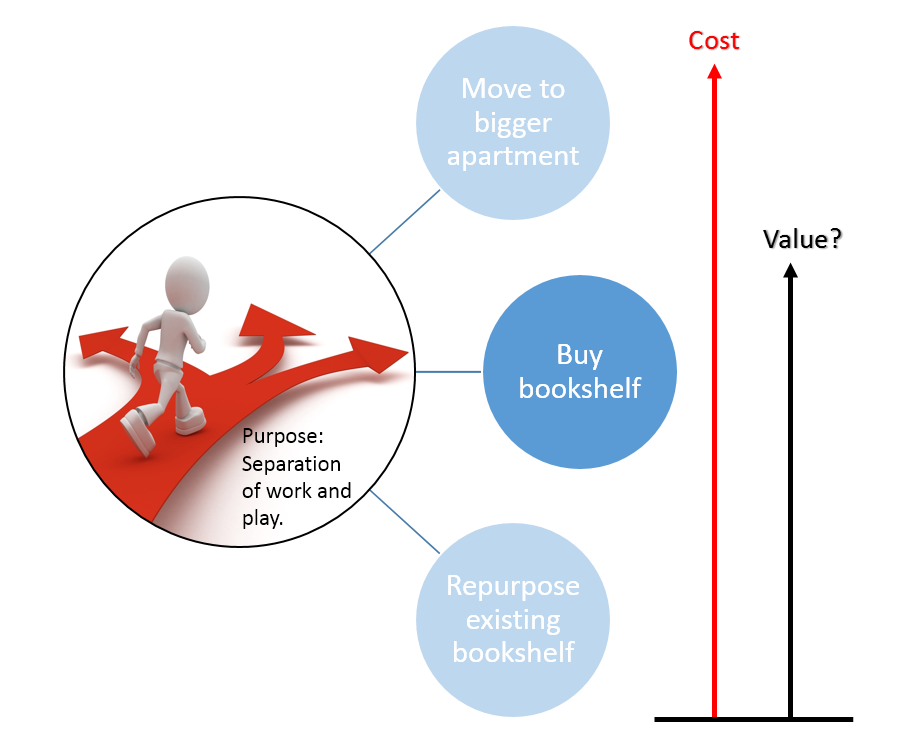Antonino and Ana share a small, one bedroom apartment in New York City. In the corner of their living room, they share a desk that serves as an office. One Saturday, Ana lamented the desire for a shelving system to organize the cacophony of office equipment scattered around one end of the couch.
Antonino, about to leave for an arduous day of shopping, was frustrated at the prospect of another day lost finding a piece of furniture that would no doubt become a burden should they ever rearrange or move. He asked Ana, “Why? What’s wrong with the current arrangement.” After a few minutes of probing, Ana expressed she was unhappy with equipment scattered about the living room. She wanted separation between work and play. Ana hoped organizing the equipment in a shelving system, hidden away from the rest of the room, would provide the much desired separation.
Along one of the walls, was a rather large bookshelf. Unfortunately, it was filled to the brim. But, it was one of those bookshelves that work well to divide a room. Antonino asked, “What if we turn the bookshelf perpendicular to the wall, hiding the desk, and creating a space for the equipment, not visible to the rest of the room?” Twenty minutes later, everything was re-arranged. The room was nicely divided: work from play. A day of shopping, the burden of even more stuff in an already tight space, and spending a chunk of change were all averted. Both Antonino and Ana were delighted with the new arrangement.
What if Antonino had set out to find a new bookshelf as instructed? It’s not hard to imagine the lack of desire to waste more time asking why. Asking why only makes for longer days, right? But even after a long day of searching, it’s possible a bookshelf might add more clutter and fail to foster the desired sense of separation.
Does this seem familiar? Not only does this happen in our personal lives, this happens in our professional lives. It’s hard enough to ask the spouse “Why?” without a negative reaction. How much more difficult is it to ask the boss, or the customer? Without this crucial information, unfortunately, we often end up wasting time, money and occasionally end up in a situation that’s worse than what we started with.
“Go buy a new bookshelf to hold the office equipment.” It doesn’t leave much room to adapt and make decisions to minimize the effort and maximize the benefit. We can only come back with a bookshelf. We may be able to decide between cheap bookshelves and expensive ones, but we can’t look for alternatives.
Compound this with the fact that much of what we’re asked to do professionally, isn’t as clear cut as buying a bookshelf. Take the world of software development. The technical jargon is so vast that even individuals entrenched in building software can’t possibly agree on what everything means. Individuals not entrenched have a different perspective based on past experiences. Everybody involved comes with preconceived notions of: what software can do, what they assume everyone else knows, what they assume doesn’t need to be said, what functionality is necessary, how to describe functionality, what technical terms mean, etc. Software functionality is simply not a universal language. It’s riddled with miscommunication. It’s one of many forms of telling people what to do that’s not as universally understood as we’d like to think.
What do we do? Instead of marching forward with the first course of action, we can change direction by asking “Why?” Ideally, we should get in the habit of explaining purpose before proposing solutions. Once Antonino uncovered the purpose, alternatives easily came to mind. Even if a bookshelf was the answer, knowing why means he can help find a bookshelf that aesthetically achieves separation, in addition to hiding the office equipment. Perhaps other factors combine to indicate it’s time to consider moving to a bigger apartment. With multiple options, Ana and Antonino can discuss the advantages and disadvantages and select the ideal course of action.
Once we understand purpose, not only can we devise alternatives, we can probe the value. What impact is desired? How significant is this? What is this worth? With this additional information, we can weed out costly alternatives and focus on a viable set of options pretty quickly. Imagine Ana had initially asked to move to a bigger apartment. After weeks of searching, perhaps they find they can’t afford a bigger apartment. After failing to remedy the situation, it’s likely Ana will be frustrated, looking for another way to provide the desired separation.
This may seem a bit of a stretch, but I’ve encountered situations where I’ve been asked to carry out a particular course of action. I proceed to determine the cost, investing time in a proposal, only to find even the most basic implementation is beyond the value. Instead of wasting time costing a non viable approach, I could’ve invested in proposing alternatives. Even worse, I’ve been involved in projects where work was billed by the hour. Instead of finding out the cost is too much upfront, we found out long after work had begun.
Would you rather pursue the first course of action, or pursue a list of alternatives and choose based on the value of each? Devising alternatives requires communicating purpose and value. What language would you prefer to speak?

1 comment for “Value is a universal language”